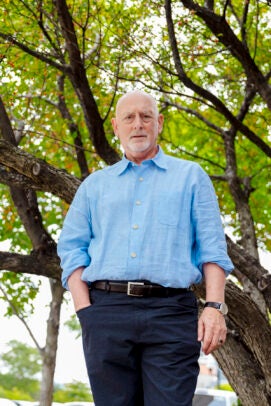博文
新的研究表明,我们正接近人类预期寿命的极限
 精选
精选
||
新的研究表明,我们正接近人类预期寿命的极限
诸平


Fig. 3 S. Jay Olshansky, professor of epidemiology and biostatistics at UIC. (Photo: Martin Hernandez/UIC)
据美国伊利诺伊大学芝加哥分校(University of Illinois Chicago简称UIC)2024年10月12日提供的消息,新的研究表明,我们正接近人类预期寿命的极限(New Research Suggests That We Are Nearing the Limit of Human Life Expectancy)。
自1990年以来,预期寿命增长已经放缓,最长寿人群的平均寿命增长仅为6.5岁,这表明可能存在生物极限。一项新的研究强调要把重点从仅仅延长寿命转移到通过老龄化科学的进步来提高生活质量。
在整个19世纪和20世纪,由于更健康的饮食、医学进步和许多其他生活质量的改善,预期寿命急剧增加。然而,根据伊利诺伊大学芝加哥分校领导的一项新研究,在20世纪几乎翻了一番之后,这种增长的速度在过去30年中显著放缓。
分析发现,尽管医学和公共卫生领域不断取得突破,但自1990年以来,世界上最长寿人口的出生时预期寿命平均只增加了6年半。这一改善速度远远低于一些科学家的预期,即本世纪预期寿命将加速增长,今天出生的大多数人将活过100岁。
人类寿命的极限(Limits to Human Longevity)
美国伊利诺伊大学芝加哥分校(University of Illinois at Chicago, Chicago, IL, USA)、美国夏威夷大学和Kuakini医学中心(University of Hawaii and Kuakini Medical Center, Honolulu, HI, USA)、美国哈佛大学(Harvard University, Cambridge, MA, USA)以及美国加州大学洛杉矶分校(University of California at Los Angeles, Los Angeles, CA, USA)的研究人员合作,在《自然衰老》(Nature Aging)杂志发表的论文——S. Jay Olshansky, Bradley J. Willcox, Lloyd Demetrius, Hiram Beltrán-Sánchez. Implausibility of radical life extension in humans in the twenty-first century. Nature Aging, Published: 07 October 2024. DOI: 10.1038/s43587-024-00702-3. https://www.nature.com/articles/s43587-024-00702-3.为21世纪人类彻底延长寿命的不可能性提供了新的证据,证明人类正在接近生物学上的生命极限。
UIC公共卫生学院(UIC School of Public Health)的首席作者S. 杰伊·奥尔尚斯基(S. Jay Olshansky)说,长寿的最大促进因素是成功地与疾病作斗争。这使得老龄化的破坏性影响成为进一步延长寿命的主要障碍。
流行病学和生物统计学教授S. 杰伊·奥尔尚斯基说:“今天大多数老年人都活在由药物制造的时间里。但是,这些医疗创可贴(Band-Aids)带来的寿命减少了,尽管它们正在加速发生,这意味着预期寿命快速增长的时期现在已经结束了。”
S. 杰伊·奥尔尚斯基补充说,这也意味着通过减少疾病来延长预期寿命可能是有害的,如果这些额外的时间不是健康的时间的话。他说:“我们现在应该把注意力转移到减缓衰老和延长健康寿命的努力上。”健康寿命(Healthspan)是一个相对较新的指标,它衡量的是一个人健康的年数,而不仅仅是活着。
这项分析是由夏威夷大学、哈佛大学和加州大学洛杉矶分校(UCLA)以及UIC的研究人员合作进行的,是关于人类寿命潜在极限的30年辩论的最新成果。
1990年,S. 杰伊·奥尔尚斯基在《科学》(Science)杂志上发表了一篇论文(a paper in Science),认为人类的预期寿命正在接近85岁左右的上限,并且已经取得了最显著的进展。其他人则预测,医学和公共卫生的进步将加速20世纪的趋势,使其进入21世纪。
支持放缓的证据(Evidence Supporting a Slowdown)
34年后,2024年《自然老龄化》(Nature Aging)研究报告中的证据支持了这样一种观点,即随着越来越多的人暴露在衰老带来的有害和不可改变的影响中,预期寿命的增长将继续放缓。这项研究调查了8个最长寿的国家(澳大利亚、法国、意大利、日本、韩国、西班牙、瑞典和瑞士)、中国香港和美国的数据。在研究期间,美国是少数几个预期寿命下降的国家之一。
S.杰伊·奥尔尚斯基说:“我们的研究结果推翻了传统的观点,即人类的自然长寿禀赋就在我们前方的某个地方,比我们今天的预期寿命要长。相反,它在30到60年的时间里就已经过去了。我们现在已经证明,尽管医学进步正在以惊人的速度发生,但现代医学对寿命的改善却越来越小。”
S.杰伊·奥尔尚斯基说,虽然本世纪可能会有更多的人活到百岁以上,但这些案例仍将是特例,不会显著提高平均预期寿命。这一结论与保险和财富管理等产品和行业背道而驰,这些行业越来越多地基于大多数人能活到百岁的假设来进行计算。S.杰伊·奥尔尚斯基说:“这是一个非常糟糕的建议,因为在本世纪,只有一小部分人能活那么久。”
但他说,这一发现并不排除医学和科学可以带来更多好处的可能性。上述论文作者认为,提高老年人的生活质量,而不是延长寿命,可能有更直接的潜力。应该加大对老年科学(geroscience)即衰老生物学的投资,这可能会为下一波健康和寿命延长埋下种子。
S.杰伊·奥尔尚斯基说:“这是一个玻璃天花板,而不是砖墙。还有很大的改进空间:减少风险因素,努力消除差距,鼓励人们采取更健康的生活方式,所有这些都能使人们活得更长久、而且更健康。我们可以通过老年科学和减缓衰老影响的努力来突破这种健康和长寿的玻璃天花板。”
这项研究得到了美国国家老龄化研究所(National Institute on Aging R01AG052030, R01AG027060–Kuakini Hawaii Lifespan Study)、美国国家儿童健康与人类发展研究所(National Institute of Child Health and Human Development P2C-HD041022)、美国国家普通医学科学研究所(National Institute of General Medical Sciences, P20GM125526–Kuakini HHP Center of Biomedical Research Excellence for Clinical and Translational Research on Aging)以及美国老龄化研究联合会(American Federation for Aging Research简称AFAR)的资助。
上述介绍,仅供参考。欲了解更多信息,敬请注意浏览原文或者相关报道。
Life Expectancy Growth Slows, Focus Turns to Healthier Aging
Despite medical advances, life expectancy gains are slowing
Over the course of the twentieth century, human life expectancy at birth rose in high-income nations by approximately 30 years, largely driven by advances in public health and medicine. Mortality reduction was observed initially at an early age and continued into middle and older ages. However, it was unclear whether this phenomenon and the resulting accelerated rise in life expectancy would continue into the twenty-first century. Here using demographic survivorship metrics from national vital statistics in the eight countries with the longest-lived populations (Australia, France, Italy, Japan, South Korea, Spain, Sweden and Switzerland) and in Hong Kong, China and the United States from 1990 to 2019, we explored recent trends in death rates and life expectancy. We found that, since 1990, improvements overall in life expectancy have decelerated. Our analysis also revealed that resistance to improvements in life expectancy increased while lifespan inequality declined and mortality compression occurred. Our analysis suggests that survival to age 100 years is unlikely to exceed 15% for females and 5% for males, altogether suggesting that, unless the processes of biological aging can be markedly slowed, radical human life extension is implausible in this century.
https://blog.sciencenet.cn/blog-212210-1455113.html
上一篇:破纪录的激光脉冲
下一篇:光子驱动的突破:面向未来的快速、安全和可持续的电信

